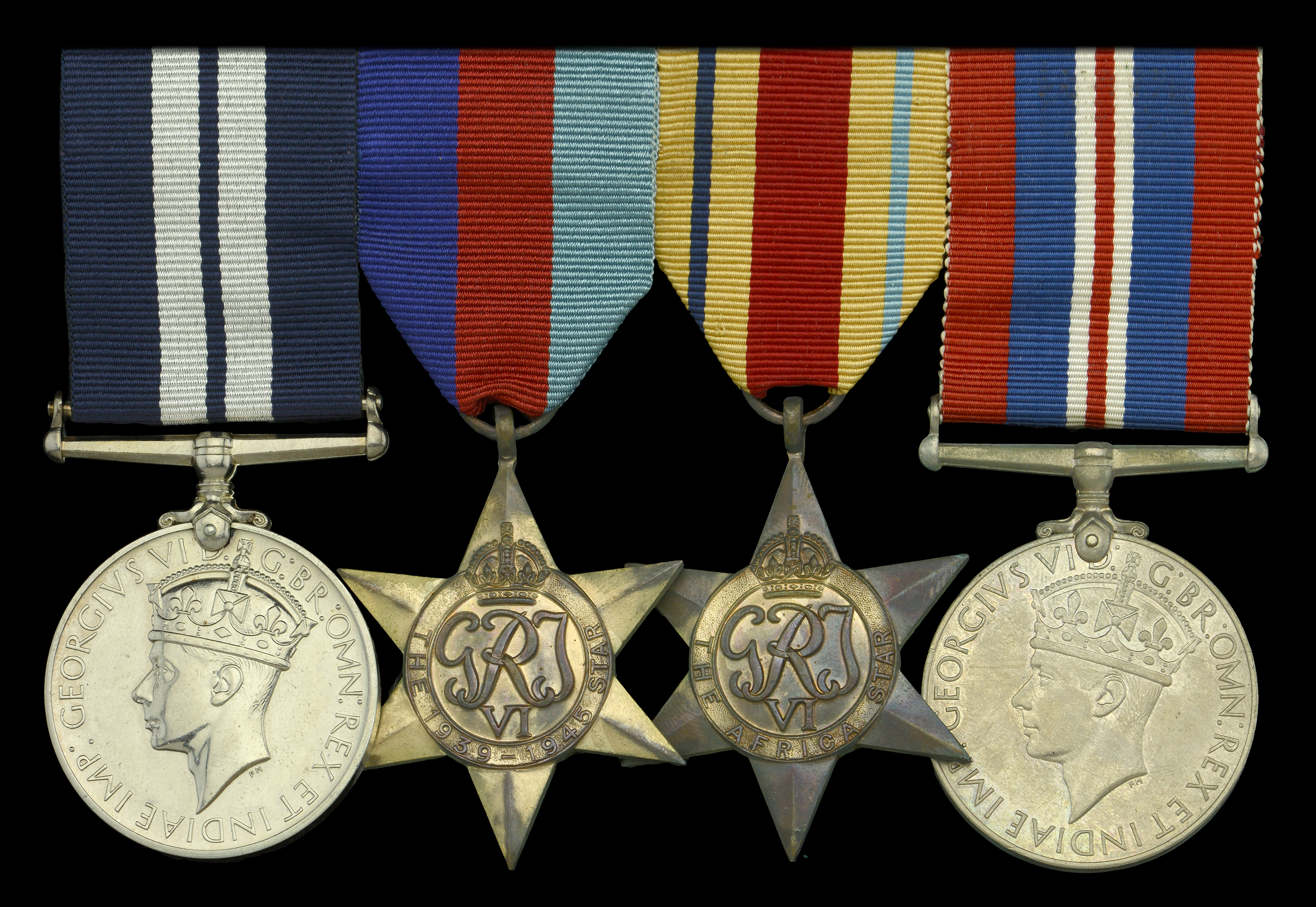The Second War submariner’s D.S.M. group of four awarded to Stoker 1st Class R. E. W. Currell, Royal Navy, who died on the occasion of the loss of H.M.S. Parthian in the Mediterranean in August 1943 Distinguished Service Medal, G.VI.R. (KX.107159 R. E. W. Currell. Sto.) impressed naming; 1939-45 Star; Africa Star; War Medal 1939-45, mounted as worn, nearly xtremely fine (4) £1,400-£1,800 --- Importation Duty This lot is subject to importation duty of 5% on the hammer price unless exported outside the UK --- --- Provenance: Dix Noonan Webb, September 1999. D.S.M. London Gazette 7 September 1943: ‘For bravery and skill in successful patrols in H.M. Submarine Parthian.’ The original recommendation states: ‘This man has at all times performed his duty at sea with great efficiency. His reliable character and cheerfulness rendered valuable assistance in evading a severe depth charge attack.’ Ronald Ernest William Currell was born in Southwark, London, on 19 February 1920. Already associated with matters nautical, being a capstan fitter on the outbreak of hostilities, young Currell volunteered for the ‘Silent Service’ in January 1941. Duly qualified and rated as a Stoker, he joined the submarine H.M.S. Parthian in August 1941, then under Lieutenant-Commander M. G. Rimington, D.S.O., R.N. Parthian, however, was on her way to the U.S.A. for a major refit and did not return to sea until February 1942, this time under Lieutenant-Commander D. St. Clair-Ford, R.N. Currell’s subsequent award of the D.S.M. was made in respect of Parthian’s war patrols in the Eastern Mediterranean in the period July 1942 to June 1943, when she was commanded not only by St. Clair-Ford, R.N. but also by Lieutenant M. B. St. John, R.N. Under St. Clair-Ford, Parthian was engaged on the Malta supply run, carrying aviation fuel and ammunition to the beleaguered island, in addition to numerous passengers and, on one occasion, ‘a dachshund dog for the Princess Ali Khan’. Such patrols, at least six of them in the period leading up to November, were undertaken from Gibraltar and Beirut and in the last of them St. Clair-Ford attacked an Italian merchantman. In retaliation, a gunboat escort dropped 23 depth charges, some of them close enough to cause damage. Later in the same month, command of the Parthian devolved to Lieutenant M. B. St. John, D.S.C., R.N., who carried out a flurry of successful patrols in the Aegean in the new year. In one of them, in March-April 1943, Parthian boarded a number of caiques, some of which were afterwards destroyed by gunfire, and bombarded a resin factory in the Gulf of Kassandra. On the latter occasion, according to a wartime newspaper report, ‘storage tanks blew up and huge pieces of metal rose three hundred feet into the air before crashing through the roofs of nearby warehouses. The crew shot accurately and deliberately for an hour, and when they left fires were blazing fiercely and dense clouds of smoke stretched for fifteen miles downwind.’ During her third patrol, in April-May 1943, a 50-ton caique was sunk by gunfire off the island of Kos. Later, however, Parthian paid dearly for a brave but inconclusive gunfight with an escort vessel in the Dorso Channel, when opposing ships dropped some 70 depth charges. Here, then, surely, the moment referred to in the recommendation for Currell’s D.S.M. Lucky to escape that episode with relatively minor damage, she went on to execute a successful bombardment of the Salonica railway line at Heraklion, her guns destroying or damaging a number of railway trucks, station buildings, and a signal box, in addition to two caiques. At length, after a rating gun-layer had been mortally wounded, she was compelled to dive. In his official report on the action Lieutenant St. John noted that ‘everyone on the bridge got peppered with splinters … and a whole bullet fell out of the First Lieutenant’s trousers at breakfast next morning.’ Parthian’s activities also included clandestine work, a patrol in early May 1943 incorporating the landing of three embarked passengers at Makri Yalo Bay on the south-east coast of Crete on the night of the 2nd. They were likely operatives of the I.S.L.D., M.I. 6’s Middle Eastern section. In late June 1943, Lieutenant C. A. Pardoe, R.N.R., assumed command of Parthian but, after one patrol, she was lost with all hands on, or about 11 August 1943, most likely a victim of a mine. Currell was just 23 years old at the time of his death. The son of James and Florence Currell of Burnt Oak, Middlesex, he is commemorated on the Chatham Naval Memorial. Sold with a file of copied research.





